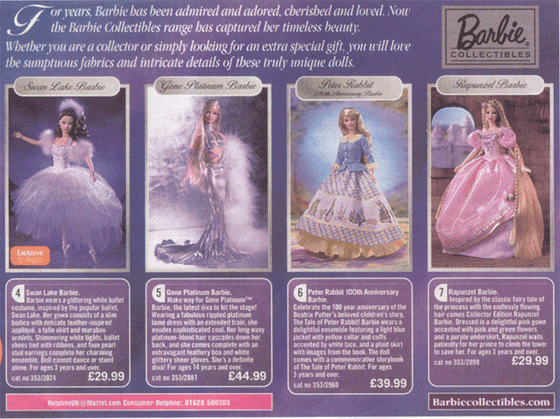Language and Gender Sample Question
QUESTION: What is the significance of gender in the text below?

Student’s Response
Despite the fact that this text does not directly address females, it centres on the ideas of social conditioning, identity and a stereotypical representation of gender. The introduction sets the scene. The discursive font, in particular the opening ‘F’ consonant, is reminiscent of fairy tales, a stereotypically female interest. The verb choices “admired”, “adored”, “cherished” and “loved” immediately add to the feeling of warmth and friendship that is so often associated with the female temperament.
Playing with dolls is seen by society as a feminine pastime and links with a mothering or maternal instinct which women should stereotypically have. In this text, the Barbie dolls (on the whole) represent traditional feminine roles. This is shown, for example, by the names given to the dolls.
The ‘Swan Lake’ Barbie refers explicitly to the stereotypical hobby of ballet. Ballet is seen as a feminine and elegant pastime rather than the more masculine, rough and active hobbies boys are expected to take part in. The ‘Rapunzel’ doll displays a representation of females as being subordinate and helpless young women who need a dominant man “to climb the tower and save her”. This doll is exploiting and reinforcing these outdated stereotypes of both sexes (the only doll to refer to men) with today’s younger generation. However, in contrast, the ‘Gone Platinum’ doll does represent, in some ways, a more modern role model to young women. It reflects the aspirations of perhaps older girls to become rich and famous pop stars – the name of this doll therefore acts as a role model to girls and is in some ways a reflection of the changing role of females in today’s society. The term ‘Diva’ is used which implies control and dominance – a female with a strong mind and individuality. However, it could be argued that the term has negative connotations. Divas are sometimes regarded as difficult and awkward, demanding materialistic items due to their elevated status. However, in this context it does appear that the doll is trying to represent individuality and assertion of power by women with an implication that women can succeed in male dominated areas such as music. The reference to ‘Gone Platinum’ has a clear link to this as the reference to platinum could be linked to selling a significant amount of CDs – a platinum disc is the highest award for music sales. Furthermore the imperative sentence which begins the description and the exclamatory sentence which ends it both have connotations of power.
This Barbie doll is, however, the only one which does not conform to a stereotypical representation of female gender. In the descriptions of the dolls there is a clear focus on appearance, beauty and fashion via a range of semantic links. The French lexis ‘appliqué’ and ‘faux’ have connotations of sophistication and elegance linked to fashion. A variety of concrete nouns within the semantic field of fashion are also used; ‘gown’, ‘skirt’ and ‘dress’ all present a stereotypical image of femininity. Within the ‘Peter Rabbit’ description, the writer attempts to imitate the language used in fashion shows and on catwalks: ‘Barbie wears a delightful ensemble featuring a light blue jacket…’. There is also an assumption that the audience, despite their young age, will have knowledge of fashion particular in relation to ballet – ‘appliqué’, ‘tulle skirt’ and ‘marabou armlets’. There is in this description a greater focus on how a ballet dancer should look rather than the more technical aspect of this hobby. This is reinforced by the declarative ‘Doll cannot dance or stand alone’.
With regard to appearance, the range of pre-modifying adjectives and adjectival phrases used to describe the clothes reinforces an obsession with looks (‘shimmering white’, ‘rippled platinum’ and ‘extravagant feathery’), whilst the additional description of ‘slim bodice’ and ‘delicate’ reinforces an image perpetuated by males and the media today with regard to gender. That is to say, women should conform to a standard image (slim) to appear attractive to men. As for beauty, the text uses descriptions of ‘long wavy platinum blond hair’ and ‘endlessly flowing hair’ to reinforce a stereotypical image of attractive women and femininity.
The colours used within the text in some ways reinforce a typical representation of gender. The use of feminine purples helps perpetuate this stereotype although the more stereotypical pink is largely absent. However, it is evident in the description of Rapunzel Barbie’s clothes: ‘pink gown’, ‘pink flowers’, ‘purple underskirt’.
Overall, this text appeals to young girls through clear references to their aspirations, hobbies and hopes. It perpetuates stereotypical views of females being obsessed with appearance, fashion and beauty and, with particular reference to the ‘Rapunzel’ doll, as the inferior, weaker gender.
|
Examiner’s Comments Very well written with excellent awareness of gender issues. Good use of terminology and well structured. Grade A |
